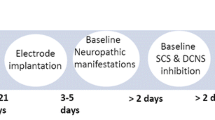Abstract
Chronic experiments on cats showed that stimulation of certain zones of the mesencephalon reduces or completely suppresses responses to pain caused by stimulation of the dental pulp. Depending on the parameters of brain stimulation the antinociceptive effect was manifested as differential changes in individual motor, autonomic, emotional, and behavioral components of the integral nociceptive response. After-analgesia was found and the dynamics of the return of the various manifestations of pain after cessation of brain stimulation was noted. The possible mechanisms of the antinociceptive effect are discussed.
Similar content being viewed by others
Literature Cited
A. V. Val'dman, The Neoropharmacology of Narcotic Analgesics [in Russian], Leningrad (1972).
Yu. N. Vasil'ev, “Effect of analgesics and narcotics on presynaptic inhibition of afferents of different modalities at the segmental level and at the level of the nucleus of the trigeminal nerve,” Author's Abstract of Candidate' Dissertation, Leningrad (1975).
Yu. D. Ignatov, “The effect of analgesics and narcotics on the neuronal system of the segmental afferent input and its descending regulation”, Author's Abstract of Candidate's Dissertation, Leningrad (1975).
Yu. D. Ignatov and Yu. N. Vasil'ev, Proceedings of the 12th All-Union Congress of the Academician I. P. Pavlov Physiological Society [in Russian], Vol. 1, Leningrad (1975), p. 22.
M. M. Kozlovskaya and A. V. Val'dman, in: Current Problems in the Pharmacology of the Reticular Formation and Synaptic Transmission [in Russian], Leningrad (1963), pp. 116–164.
H. Akil and D. J. Mayer, Brain Res.,44, 692 (1972).
S. Balagura and T. Ralph, Brain Res.,60, 369 (1973).
J. M. Broockhart, W. K. Livingston, and F. P. Haugen, J. Neurophysiol.,16, 634 (1953).
J. C. Liebeskind, G. Guilbaud, J. M. Besson, et al., Brain Res.,50, 441 (1973).
D. J. Mayer and J. C. Liebeskind, Brain Res.,68, 73 (1974).
R. Melzack and D. R. Melinkoff, Exp. Neurol.,43, 369 (1974).
J. L. Oliveras, A. Woda, G. Guilbaud, et al., C. R. Acad. Sci. (Paris),276, 2705 (1973).
D. V. Reynolds, Science164, 444 (1969).
D. J. Scott and G. G. Stewart, Oral Surg.,20, 784 (1965).
R. S. Snider and W. T. Niemer, A. Stereotaxic Atlas of the Cat Brain, Chicago (1961).
Rights and permissions
About this article
Cite this article
Ignatov, Y.D., Dmitriev, A.V. Effect of mesencephalic stimulation on responses to nociceptive stimulation of the dental pulp. Bull Exp Biol Med 82, 1445–1448 (1976). https://doi.org/10.1007/BF00799772
Received:
Issue Date:
DOI: https://doi.org/10.1007/BF00799772




